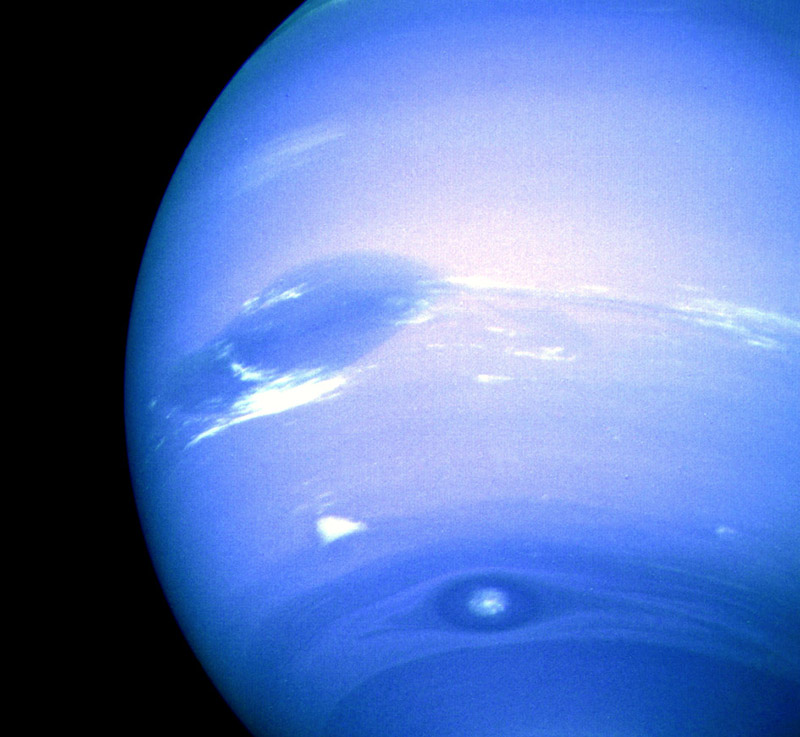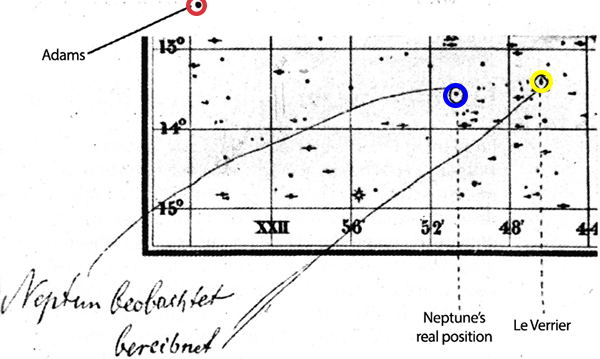Located 4,497 million kilometers away, Neptune is the eighth planet in its distance from the Sun and is the fourth in size. The interior structure of Neptune is probably similar to that of Uranus. Studies suggest the existence of a rocky core whose size is several times the size of the Earth, surrounded by large sheets of ice. Even though it looks like a uniformly bluish planet, Neptune has some visible features in its atmosphere: narrow, elongated clouds of methane. It also has a stain called Great Dark Spot (similar in size to the Earth), produced by the same dynamics that generate the Great Red Spot of Jupiter. Neptune radiates more energy into space than it receives from the Sun. This is explained because the gases, when contracting inside, heat up and radiate their heat.
The last planet in the Solar System
Even though it is so far away, various information has been obtained thanks to the Voyager probes, as well as images obtained with the Hubble Space Telescope and, more recently, with the James Webb Space Telescope (JWST). Neptune has rings, a bluish coloration and a large atmospheric storm that exceeds Jupiter's Red Spot in size, although this is not as impressive because it does not present a color contrast with respect to the planet.

Neptune has a similar appearance to Uranus, mainly in the temperature of the high clouds, reaching -214 °C. A detail to consider is the influence that it exerts on its largest satellite, Triton, which within hundreds of millions of years will inevitably fall in a spiral on the planet, as has been proven according to astronomers, who imagine a collision as spectacular as when the Comet Shoemaker-Levy 9 crashed into Jupiter in July 1994. The wind speed in Neptune's atmosphere reaches 2,000 km/h, making it the fastest in the Solar System.
Neptune, as well as its largest satellite (Triton), have been explored by the Voyager 2 probe in 1989. Among the discoveries made, is the great dark spot in its atmosphere (a huge storm system) and its strong winds, this to despite being at the limits of the system, where solar radiation is weaker. It has been postulated that one reason may be precisely the lack of sunlight, with less energy that can alter the winds.

Neptune is not visible to the naked eye, but we have been able to observe it thanks to the Hubble and James Webb space telescopes, the latter providing intriguing The most recent observations of Neptune have been made with the James Webb space telescope, since . Powerful telescopes are needed to see it as a bluish disk, similar to Uranus.
Towards the end of the 18th century, Pierre-Simon Laplace began to develop Mécanique Céleste, one of his greatest works, addressing problems left behind by Isaac Newton. One of these problems was being able to calculate the planetary orbits, and knowing if they coincided with the observations of the time. One of Laplace's students was in charge of this task, doing the respective calculations for the gaseous planets.

Although he had success with Jupiter and Saturn, Uranus presented him with a problem. It just didn't match. In his preliminary conclusion, he said that there were problems with the observations, or, that another body unknown to date was gravitationally perturbing the orbit of Uranus.
Two researchers, the Englishman John Adams and the Frenchman Urbain Le Verrier, made new calculations to find out where this hypothetical body that was disturbing the orbit of Uranus would be. In 1846, Le Verrier published an estimate of the unknown planet's orbit. Adams, on the other hand, also showed interest when he saw that his calculations were similar, so efforts were made to observe it from the Cambridge Observatory, although there was no success.
In the top figure The predictions of Adams and Le Verrier are shown, while the blue box shows the actual position for the foreign body. You can see that Le Verrier was closer. The genesis of this discovery came when the Frenchman requested to observe that area of the sky, while the comparison of old maps of the sky with more recent ones was also managed. Finally, on September 23, 1846, the new planet was discovered: Neptune.
| CHARACTERISTICS | |
| Diameter | 49,572 km |
| Mass | 1,024 x 1026 kg |
| Density | 1.64g/cm3 |
| Gravity | 11.0 m/s2 |
| Surface temperature | -220 ºC (med) / -223 ºC (min) |
| Axial inclination | 29.58° |
| Escape velocity | 23.71 km/s |
| Rotation | 16h6m |
| Translation | 164 to 288 d 1 p.m. |
| Orbital speed | 5.47 km/s |
| Eccentricity | 0,00858587 |
| Albedo | 0,41 |
| Distance to the Sun (average) | 4,498,252,900 (30.06 AU) |
| Number of satellites | 14 |

